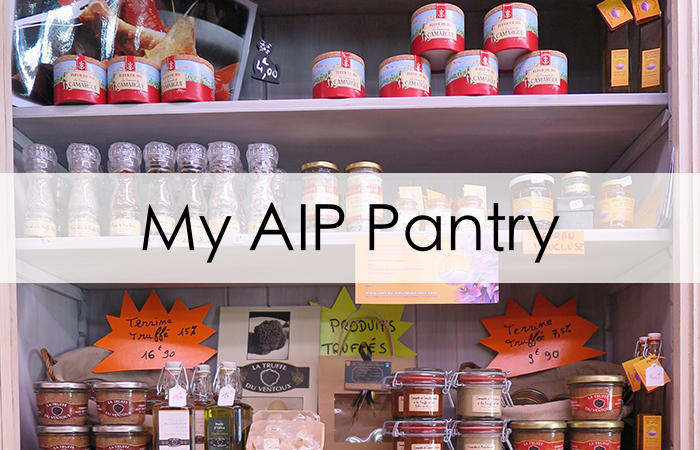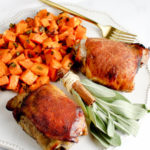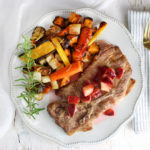 You might wonder which items you should keep in your kitchen pantry to make your life easier! I have compiled a list of my AIP pantry staples. These are all ingredients compliant with the Paleo Autoimmune Protocol. I use them on a daily basis to prepare food for my family and myself (and I used them to create all the recipes in my cookbooks Simple French Paleo and The Autoimmune Protocol Made Simple). Along with lots of fresh vegetables, fruit, meat, and seafood, these items represent the core of my diet. There aren’t that many of them, which means that you can quickly build yourself a well-stocked AIP pantry. I can find most of these items at my local health food store. If I can’t find something there, I will buy it online on Amazon.
You might wonder which items you should keep in your kitchen pantry to make your life easier! I have compiled a list of my AIP pantry staples. These are all ingredients compliant with the Paleo Autoimmune Protocol. I use them on a daily basis to prepare food for my family and myself (and I used them to create all the recipes in my cookbooks Simple French Paleo and The Autoimmune Protocol Made Simple). Along with lots of fresh vegetables, fruit, meat, and seafood, these items represent the core of my diet. There aren’t that many of them, which means that you can quickly build yourself a well-stocked AIP pantry. I can find most of these items at my local health food store. If I can’t find something there, I will buy it online on Amazon.
As a general rule, always read your labels carefully
and avoid any additives, preservatives, chemicals, and added sugar.
- Apple cider vinegar
: I often use apple cider vinegar for it’s fresh and zesty flavor in my salad dressings, combined with olive oil; as well as in marinades.
- Arrowroot starch/flour
: I use arrowroot as a substitute for cornstarch and traditional baking flours, as a thickening agent in sauces, and to lighten the heavy texture of other flours in baked goods.
- Avocado oil
: I use avocado oil whenever I can’t use olive oil. For instance, when baking in the oven at high temperatures over 350° F, or when the more pungent taste of olive oil would be too strong for the preparation (for example when making AIP mayonnaise).
- Baking powder: I use baking powder as a leavening agent to increasing the volume and lightening the texture of baked goods. Unfortunately, most commercial baking powders contain aluminum and/or cornstarch. The best way to avoid this is to make your own baking powder by mixing 1 teaspoon of cream of tartar
with 1/2 teaspoon of baking soda
. Keep your homemade baking powder in an airtight container and away from moisture.
- Balsamic vinegar
: Balsamic vinegar is a condiment made from white grape juice. It has a rich and complex sweet flavor that can be used to enhance the seasoning of salad dressings, marinades, sauces, and even meat and seafood.
- Capers
: Capers are actually unripened flower buds from a perennial plant native to the Mediterranean. Usually brined in salt or vinegar, they give a lemony burst of flavor to foods. I use capers preserved in sea salt, especially when making French tapenade. Salt-packed capers should be soaked in water and then rinsed a few times to remove excess salt before used in cooking.
- Carob powder (roasted)
: Carob is commonly used as a chocolate substitute and doesn’t contain any caffeine. Be careful to check labels as commercial carob chips and powders often contain barley and/or dairy ingredients. I have yet to find an AIP compliant brand of carob chips.
- Cassava flour
: I use cassava flour frequently when baking. It is a grain-free and nut-free replacement for wheat flour and brings a wonderful consistency to baked goods. Cassava flour is made from the entire cassava (or yuca, or manioc) root, without the peel. Not to be confused with tapioca, which is the bleached and extracted starch of yucca root. The same original ingredient, but totally different processes.
- Coconut aminos
: Coconut aminos are a seasoning sauce very similar to soy sauce, except made from coconut.
- Coconut butter (raw)
: Made from puréed coconut flesh, coconut butter is an excellent replacement for traditional nut butter. For the ultimate sweet indulgence, try stuffing a date with coconut butter and savor! I also use it occasionally in desserts.
- Coconut flakes (unsweetened)
: Coconut flakes are made from dehydrated coconut flesh. Always purchase them unsweetened as commercial versions may contain a lot of added sugar. I love to eat them as is as a crunchy snack. I also use shredded coconut in some of my desserts and snacks as a basic ingredient or sprinkled as a garnish.
- Coconut flour
: This versatile flour is obtained from finely the ground dried meat of a coconut. Its rich texture and natural sweetness are great for baking. Use it sparingly though because coconut flour tends to absorb a lot of liquid due to its fiber content.
- Coconut milk
: If you are buying coconut milk, make sure it doesn’t contain any additives like guar gum or xantham gum, which can alter the gut microbiome and should be avoided while on the autoimmune protocol. I use coconut milk often in the kitchen when cooking (especially to create creamy sauces or in soups), baking (as a dairy replacement), and in smoothies. To learn more about AIP-compliant coconut milk, click here.
- Coconut oil
: Coconut oil is a very healthful oil to use in the kitchen. It has a creamy consistency. It is suitable for high temperatures cooking and baking. I also use it in my personal care for oil pulling. There are several good brands out there, so when making your selection, look for unrefined, cold-pressed virgin coconut oils. Note that coconut oil will stay solid at normal room temperature.
- Coconut wraps
: These are an excellent replacement for tortillas and great to have on hand for an emergency “sandwich”.
- Dates
: Dates can be used as a natural sweetener in baking, or as a snack when you want a little something sweet. My favorites are Medjool dates. Limit your consumption though as they pack a lot of sugar! I purchase mine in bulk at my local health food store. I also love using granulated date sugar when baking. Granulated date sugar lends a gentle sweetness to baked goods and packs in a fiber and mineral power punch not found in most other sweeteners.
- Dried herbs and spices: Herbs and spices are great to add flavor and depth to any dish! My favorites are cilantro
, herbes de Provence
, lavender
, oregano
, parsley
, rosemary
, sage
, and thyme
. I like to keep a stock of these herbs in my kitchen. Wherever possible, I prefer to use fresh herbs and I grow some of them in my vegetable garden. As a general rule, when substituting fresh herbs in a recipe that calls for dry, use three times as many fresh. For example, you can swap 1 teaspoon of dried sage with 1 tablespoon of chopped fresh sage.
- Extra-virgin olive oil
: By far my favorite oil to use in the kitchen, extra-virgin olive oil is suitable for cooking and baking up to 350° F. Always choose extra-virgin, first cold pressed olive oil, sold in a dark glass bottle. Store your olive oil in a cold place, away from direct sunlight. I like to rotate the brands of olive oil I use because their taste can vary greatly.
- Fish sauce
: Made from fresh black anchovies and salt, fish sauce will give your Asian dishes, or any seafood-based recipe a distinctive umami flavor!
- Gelatin (unflavored)
: Gelatin is a protein powder with many health benefits (joint care, gut, hair, nails). I often use gelatin when preparing treats and desserts. It can be used as an egg replacer in cookies and cakes, and is the secret ingredient for making gummies and fruit terrines! I would recommend to only use the porcine gelatin when baking though, as the bovine gelatin has a stronger taste.
- Honey
: Honey is a natural sweetener suitable for the autoimmune protocol. Use it sparingly. It is better to choose raw, local, and organic honey whenever possible. I use it as a sweetener when baking.
- Maple syrup
: Maple syrup is a natural sweetener and its unique flavor makes it ideal for baking. Grade B maple syrup is preferable as it has a richer, deeper flavor than grade A, as well as higher nutrient content.
- Olives
: I like to keep olives on hand to eat as a savory snack or to use as an ingredient in many dishes. I personally prefer Kalamata olives for their rich and fruity flavor, especially when preparing French tapenade. They come packed in olive oil and vinegar. Be sure to check the label for sneaky non-AIP ingredients!
- Palm shortening
: I use palm shortening in lieu of butter in baked goods. It is solid at room temperature and is odorless, and flavorless. If you can’t source palm shortening, try this: replace with 6 parts coconut cream with 1 part coconut oil and refrigerate.
- Sea salt: Because I use sea salt so often to bring out the natural aromas of food, I make sure to buy only the finest. My favorites are Celtic sea salt
, Himalayan pink sea salt
, and last but not least French Fleur de Sel
. Sea salt is naturally packed with beneficial trace minerals. Whichever sort you choose, make sure it is unbleached, unrefined, and devoid of anti-caking agents and additives.
- Tigernuts
: Tigernuts are not actually nuts, but small root vegetables with a slightly nutty flavor. They are delicious as a snack, despite the fact that they are really hard to chew on!
- Tigernut flour
: Tigernut flour is a fine powder made of ground tigernuts. Because it has a light taste and a consistency close to white flour, I like to use it in baked goods.
- Vanilla: I use vanilla frequently when baking to impart a sweet vanilla aroma to cookies and cakes. You can use vanilla extract
when baking (the alcohol will be cooked off). I like the Simply Organic brand
. For cold preparations, a good option is vanilla powder
. It is more pricey though than vanilla extract, but you only use a small amount at a time. Make sure there is no added sugar or fillers in the ingredients. In recipes, you may substitute 1/2 teaspoon of vanilla powder to 1 teaspoon of vanilla extract.






I’m wondering if I don’t like carob because the brand I’ve tried is raw, and you have a roasted one linked here? Neat post Sophie! xx
Thanks Mickey for stopping by! Yes, roasted carob taste different from raw, and it does behave differently in recipes. I think that roasted carob is easier to use, more soluble.
I have everything except the fish sauce & tigernuts…
I want a close up and detailed description of everything in those lovely jars! Do you do all your own canning?
Haha it took me a while to understand what you meant 🙂 You mean the jars in the picture!! These are not mine. I took this picture in a little delicatessen store in France, more particularly in Provence. It was a tiny little village store with local homemade goodies, such as pâtés, candies, jams and jellies, fruit pastes, etc. Isn’t lovely?
I’m so happy to find your site! I’ve been on a strict diet for several months and my antibodies and inflammatory markers are worse than ever! My doctor finally told me to follow the autoimmune protocol and I never heard of it and found this through Pinterest. Thank you for all this information, I feel like I can actually do this now!
Thank you for your positive feedback Kimberly and good luck in your healing journey 🙂
Why no beans & seeds on this diet? I’m close to being vegan & love to eat them. Thanks!
Hello Terri,
Here is a great article from The Paleo Mom explaining why beans are not allowed on this diet. The truth about beans
And here is another one explaining why nuts and seeds are not allowed on the Autoimmune Protocol. Nuts and seeds
I hope this helps 🙂
This is Day 1 for me on the AIP. Of all the diets I’ve read about in my RA support group, this was the one I thought, impossible, because everything I eat on a daily basis is on the NO page. There seems to be not much of a selection on the YES page of foods that I like.
If I can’t have nuts and seeds, does that mean, I can’t have sesame oil? or other nut oils?
That is correct, no nut and seed oils as well. – Sophie
Great post. I love the tigernut flour which I keep in a cupboard, but I mfound when I took it out to make one of your cookie recipes it had mold on it. Is ut supposed to be stored in the refrigerator? I had used it earlier and it was a few months old.
Hi Nancy,
Wow, I am not sure what went wrong with the tigernut flour. Do you live in a humid climate? If the flour is moldy, it has been exposed to humidity somehow, somewhere. I live in Colorado so it is super dry here and I keep my flours in an airtight container in the pantry. Not sure if this will help you!
I live in Oregon. I’ll call the company to see if they have any recommendations for storage. I still want to make those cookies!
Hi! Quick question regarding arrowroot, tigernut, and cassava flour! I read somewhere in my research that all of theses flours are derived from nightshades and should be avoided; however, almost all AIP recipes (esp baked goods) call for them. I have been trying to find the exact article but can’t! Can you offer any insight about when/if these flours should be avoided? It is overwhelming, and I’m finding it hard to make my daughter any kind of baked goods with just coconut flour! The consistency doesn’t work! Thanks so much!
Indeed, arrowroot, tigernut, and cassava flours are on the approved list of AIP ingredients. However, I would use them, and make baked goods, only for special occasions. It is best to keep sugar and processed foods consumption to a minimum, giving the priority to whole foods such as meat, seafood, vegetables, and fruit. Does that make sense? – Sophie
Not doing Paleo but have 97% of the items in my pantry.
I’m a beginner and this list is exactly what I needed to take to my local natural foods store . I do have a question for you . Do you think my Hashimotos can lead to gastritis attacks ?. I’ve been so ill and had every test with every type of Doctor over the last two years and the results are stomach inflammation , but of course no suggestions to improve this problem . I’m now trying to learn more and help myself . Thank you
Hello Jamie,
What I do now is that autoimmune disease often goes hand in hand with a compromised digestive system (from problems in the mouth to problems at the very bottom!). So as you clean up your diet and slowly heal from your autoimmune disease, your digestion should normally improve. Have you been able to detect which foods are causing the more distress?
This is like 3 years late but I’ve found hashimoto’s often ties to endometriosis as well which would explain your gastritis. Just a thought, I’m not a professional. Hopefully it helps!
Thank you for putting this list together! I have everything but tigernut powder and vanilla powder. Is vanilla bean powder the same as vanilla powder? What about Madagascar bourbon vanilla powder? This may be a silly question, but does it contain bourbon?
You are welcome! Yes, vanilla bean powder is the same as vanilla powder as Madagascar bourbon vanilla powder. There is no bourbon, it is just the origin and type of vanilla used 🙂
Thank you for putting this list together. It has a wealth of information. I love having food brands rather than wasting my money. I found you through Pinterest and Instagram. I have been on a Paleo diet for about 4 years becuase of Celiac and Colitis and I’m still having issues. I am tweaking with AIP. soon. I’ve been reading alot lately about a couple of other things I could eliminate. Thanks so very much for sharing Sophie
Sarah
Thanks for stopping by Sarah 🙂
Awesome list, I wasn’t sure if Capers were AIP – thanks for clearing that up for me 🙂
Ive been on the Wahls autoimmune protocol for a year and prior to that was on the SIBO diet for small intenstine bacterial overgrowth. My diet is dairy free, sugar free, gluten free, and grain free and am reluctant ot purchase another cookbook because so many others have included dairy or sugar in many recipes. The SIBO diet allowed me to finally eat after years of suffering, but was too late for my autommune. The wahls diet has been amazing for me but i am very interested in your simplified method.
Thanks for puttung thus list together. From my understanding, regular vanilla is not AIP compliant because they often use the bean pod and not just the seed. Gluten-free vanilla extract (alcohol will cook off), grain-free, sugar-free vanilla powder, and possibly fresh vanilla bean scrapings are elimination-phase legal.
Do you have a book of recipes with UK ingredients?
Do you mean ingredients listed in metric measurements instead of imperial? Both of my cookbooks have the metric measurements, either directly in the recipes, or in conversion tables. Hope this helps! – Sophie
Now I know I’m well stocked as I have all of your list on hand. Thank you Sophie, and Happy New Year.
Watch those Medjool dates. I ordered a two pack from Costco and ended up gobbling down half a large bag before coming to my senses. They are entirely too delicious . I ended up putting the remaining half bag in the trash, donating the second bag to a food bank and adding “dates” to my personal trigger food list.
I’m on a specific AIP type diet from my naturopathic doctor. But he isn’t much help with putting things into practice. I am reacting to vanilla and apple cider vinegar (anything apple), but find one or both of these ingredients in MANY of the recipes I’m finding. Any suggestions on how to replace them? Thank you!
Hello Amy,
Try replacing apple cider vinegar with some lemon juice! – Sophie
Great list, so helpful (and hopeful) as I’m just starting and running out of ideas. Thank you
This is a great list…but the fish sauce has 1400+mg of sodium for only 1 tablespoon??? That is insane! Do you know of another lower-sodium brand with simple organic ingredients?
Thank you for your very helpful site. I have been on the Repair Vite diet to slow down and heal fatty liver disease in addition to
an overactive adrenal gland and fatigue.
At first the diet was very difficult especially
needing to avoid all sugar, grains, eggs and dairy., nightshades, among other foods. I did not think making breads would be allowed. Coconut milk is great but the flour is hard to work with as it consumes a lot of moisture. I wondered about chicory Rita’s an alternate sweetener but cannot find it.
Hello Nancy!
You are right, coconut flour absorbs a lot of moisture. I find I like it better when I mix a small amount of coconut flour with other AIP-approved flours such as cassava flour or tigernut flour. I don’t know about the Rita product you are referring to. For natural sweeteners, I usually use honey, maple syrup, granulated date sugar, or granulated coconut sugar. Thank you so much for stopping by and leaving me a comment 🙂
I am new to this diet, but I have seen a few contradictions in terms of what is allowed and not allowed. I’ve read that honey is not AIP. Could you clarify for me? It’s quite confusing! Thanks!
Hello Eliana,
This is a very good question. Honey is allowed on AIP, but in small quantities because, even if it is a natural, healthy, unrefined sugar, honey can still spike your blood sugar levels. Does this make sense? – Sophie
How can I find a list for this diet
Sign up for my newsletter and yu’ll receive it in your welcome kit.